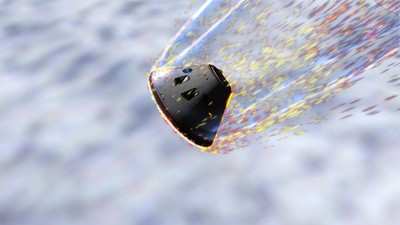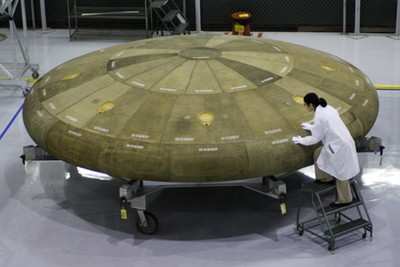Avcoat Ablation Selected Over PICA Tiles
NASA has chosen the material for a heat shield that will protect
a new generation of space explorers when they return from the moon.
After extensive study, NASA has selected the Avcoat ablator system
for the Orion crew module.

Orion is part of the Constellation Program that is developing
the country's next-generation spacecraft system for human
exploration of the moon and further destinations in the solar
system. The Orion crew module, which will launch atop an Ares I
rocket, is targeted to begin carrying astronauts to the
International Space Station in 2015 and to the moon in 2020.
Orion will face extreme conditions during its voyage to the moon
and on the journey home. On the blistering return through Earth's
atmosphere, the module will encounter temperatures as high as 5,000
degrees Fahrenheit. Heating rates may be up to five times more
extreme than rates for missions returning from the International
Space Station.
Orion's heat shield, the dish-shaped thermal protection system
at the base of the spacecraft, will endure the most heat and will
erode, or "ablate," in a controlled fashion, transporting heat away
from the crew module during its descent through the atmosphere.
 To protect the spacecraft and its
crew from such severe conditions, the Orion Project Office at
NASA's Johnson Space Center in Houston identified a team to develop
the thermal protection system, or TPS, heat shield. For more than
three years, NASA's Orion Thermal Protection System Advanced
Development Project considered eight different candidate materials,
including the two final candidates, Avcoat and Phenolic Impregnated
Carbon Ablator, or PICA, both of which have proven successful in
previous space missions.
To protect the spacecraft and its
crew from such severe conditions, the Orion Project Office at
NASA's Johnson Space Center in Houston identified a team to develop
the thermal protection system, or TPS, heat shield. For more than
three years, NASA's Orion Thermal Protection System Advanced
Development Project considered eight different candidate materials,
including the two final candidates, Avcoat and Phenolic Impregnated
Carbon Ablator, or PICA, both of which have proven successful in
previous space missions.
Avcoat was used for the Apollo capsule heat shield and on select
regions of the space shuttle orbiter in its earliest flights. It
was put back into production for the study. It is made of silica
fibers with an epoxy-novalic resin filled in a fiberglass-phenolic
honeycomb and is manufactured directly onto the heat shield
substructure and attached as a unit to the crew module during
spacecraft assembly.
PICA, which is manufactured in blocks and attached to the
vehicle after fabrication, was used on Stardust, NASA's first
robotic space mission dedicated solely to exploring a comet, and
the first sample return mission since Apollo.
"NASA made a significant technology development effort,
conducted thousands of tests, and tapped into the facilities,
talents and resources across the agency to understand how these
materials would perform on Orion's five-meter wide heat shield,"
said James Reuther, the project manager of the study at NASA's Ames
Research Center at Moffett Field, CA. "We manufactured full-scale
demonstrations to prove they could be efficiently and reliably
produced for Orion."
Ames led the study in cooperation with experts from across the
agency. Engineers performed rigorous thermal, structural and
environmental testing on both candidate materials. The team then
compared the materials based on mass, thermal and structural
performance, life cycle costs, manufacturability, reliability and
certification challenges. NASA, working with Orion prime contractor
Lockheed Martin, recommended Avcoat as the more robust, reliable
and mature system.
"The biggest challenge with Avcoat has been reviving the
technology to manufacture the material such that its performance is
similar to what was demonstrated during the Apollo missions," said
John Kowal, Orion's thermal protection system manager at Johnson.
"Once that had been accomplished, the system evaluations clearly
indicated that Avcoat was the preferred system."

In partnership with the material subcontractor, Textron Defense
Systems of Wilmington, MA, Lockheed Martin will continue
development of the material for Orion. While Avcoat was selected as
the better of the two candidates, more research is needed to
integrate it completely into Orion's design.
 ANN's Daily Aero-Linx (04.16.24)
ANN's Daily Aero-Linx (04.16.24) Aero-News: Quote of the Day (04.16.24)
Aero-News: Quote of the Day (04.16.24) Airborne 04.10.24: SnF24!, A50 Heritage Reveal, HeliCycle!, Montaer MC-01
Airborne 04.10.24: SnF24!, A50 Heritage Reveal, HeliCycle!, Montaer MC-01 Airborne 04.12.24: SnF24!, G100UL Is Here, Holy Micro, Plane Tags
Airborne 04.12.24: SnF24!, G100UL Is Here, Holy Micro, Plane Tags Airborne-Flight Training 04.17.24: Feds Need Controllers, Spirit Delay, Redbird
Airborne-Flight Training 04.17.24: Feds Need Controllers, Spirit Delay, Redbird





